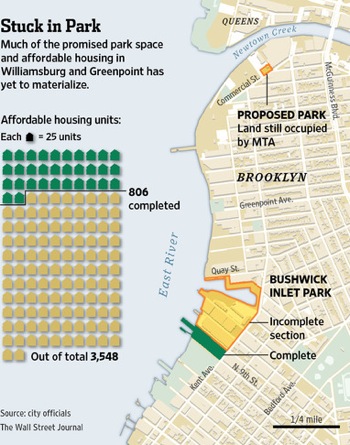Matt Chaban tries, valiantly, but unsuccessfully, to get some information out of our new Parks commissioner.
Rethinking Building Code, Post Sandy
From the Times, some opening thoughts on revamping the building code in a post-hurricane city. The focus for now is on how to build better in a rising-sea level world, versus just not building in Zone A at all (as a rather silly recent “resolution” from Community Board 1 wants).
As the Times notes, some projects have already gone beyond the current City code requirements for construction in a flood plain, and at least one of those (a recycling plant in Sunset Park) avoided flooding during Sandy as a result. Locally, the new development on the Williamsburg waterfront has also fared comparatively very well. While the flooding on this side of the river seems to have been less severe than it was just across the river, there was flooding. But Schaefer’s Landing, 184 Kent, Northside Piers and the Edge all came through the storm much better than a lot of other newer developments. Unlike many high-rises in lower Manhattan that remain unoccupiable and will be so for months, the systems in the Williamsburg developments survived and the buildings were occupiable pretty much as soon as the evacuation orders were lifted. I know at least one of our waterfront buildings took on a substantial amount of water during the storm surge, but had storm-surge mitigation mechanisms in place that worked, thus avoiding major damage within the building.
Are there lessons to be learned from the local experience, or were we just lucky? (Some of both, I suspect.)

